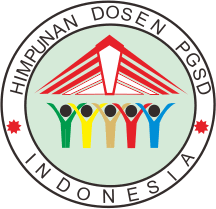Aktivitas belajar kelompok di masa pandemi covid-19 ditinjau dari motivasi belajar peserta didik kelas V sekolah dasar
Abstract
Keywords
Full Text:
PDFReferences
[1] S. Busyra and L. Sani, “Kinerja Mengajar dengan Sistem Work From Home (WFH) pada Guru di SMK Purnawarman Purwakarta,” IQ (Ilmu Al-qur’an) J. Pendidik. Islam, 3(1), pp. 1–16, 2020.
[2] L. Karismawati, S. Sukarno, and M. I. Sriyanto, “Analisis aktivitas belajar bahasa Indonesia tema 5 di rumah selama pandemi covid-19 peserta didik kelas IV sekolah dasar,” Didakt. Dwija Indria, 9(4), pp. 8–13, 2021.
[3] C. V Tirajoh, H. Munayang, and B. H. R. Kairupan, “Dampak Pembelajaran Jarak Jauh Terhadap Kecemasan Orang Tua Murid di Masa Pandemi Covid-19,” J. Biomedik JBM, 13(28), pp. 49–57, 2021
[4] A. Cahyani, I. D. Listiana, and S. P. D. Larasati, “Motivasi Belajar Siswa SMA pada Pembelajaran Daring di Masa Pandemi Covid-19,” IQ (Ilmu Al-qur’an) J. Pendidik. Islam, 3(1), pp. 123–140, 2020.
[5] Pujiman, Rukayah, and Matsuri, “Penerapan prinsip manajemen kelas dan pengaruhnya terhadap motivasi belajar siswa di sekolah dasar,” J. Pendidik. Indones., 7(2), pp. 124–128, 2021.
[6] Amirudin, S. H. Hayati, Supriyatin, S. Dewi, and Y. Ismeliantika, “Strategi Menghidupkan Motivasi Belajar Siswa Sekolah Dasar di Masa Pandemi Covid-19 Melalui Kelompok Belajar,” Islam. Educ. J., 3(1), pp. 1–13, 2021.
[7] R. P. Dewi and S. N. Hidayah, “Tugas Akhir Semester ” Studi Kasus ” Metode Penelitian Kualitatif Oleh : Jurusan Syariah Sekolah Tinggi Agama Islam Negeri ( STAIN ) Sorong,” pp. 1–30, 2019.
[8] U. Sidiq and M. M. Choiri, Metode Penelitian Kualitatif DiBidang Pendidikan, Pertama. Ponorogo: CV Nata Karya, 2019.
[9] Sugiyono, Metode penelitian kuantitatif, kualitatif dan R&D_2019. Bandung: Alfabeta, 2019.
[10] N. Harahap, Penelitian Kualitatif. Medan Sumatera Utara: Wal ashri, 2020.
[11] H. B. Uno, N. Lamatenggo, and N. P. Solong, Teori Variabel Keguruan dan Pengukurannya. Gorontalo: Sultan Amai Press, 2014.
[12] D. Pratiwi and Nurmayani, “Meningkatkan Motivasi Belajar Siswa Menggunakan Model Pembelajaran Complete Sentence Mata Pelajaran Bahasa Indonesia di Kelas V MIS Madrisatul Ikbar.,” J. Sekol., 4(1), pp. 57–62, 2019.
[13] Husniah, “Pengaruh Strategi Pembelajaran dan Motivasi Belajar Terhadap Hasil Belajar Pendidikan Agama Islam Siswa Sekolah Dasar Negeri 1 Birem Kabupaten Aceh Timur,” Universitas Islam Negeri Sumatera Utara, 2018.
[14] E. Ambarningrum and S. T. Y. Slamet, “Pengaruh model pembelajaran student team achievment divisions ( STAD ) dan motivasi belajar terhadap kemampuan menulis puisi anak,” J. Pendidik. Indones., 7(4), pp. 1–5, 2020.
[15] D. Harefa, E. Gee, M. Ndruru, and M. Sarumaha, “Penerapan Model Pembelajaran Cooperative Script untuk Meningkatkan Hasil Belajar Matematika,” J. Kaji. Pendidik. Mat., 2682(1), pp. 13–26, 2020.
[16] R. C. Hastari, “Penerapan Strategi Tutor Sebaya Dalam Meningkatkan Motivasi Belajar matematika,” J. ABDIMAS Unmer Malang, 4(1), pp. 46–50, 2019.
[17] F. N. Lestari and W. Miftakhul’Ulum, “Analisis bentuk kedisiplinan siswa dalam mengikuti kegiatan belajar dengan motivasi belajar siswa kelas IV SDN i Gondosuli Gondang,” J. Pendidik. Dasar Nusant., 5(2), pp. 318–329, 2020.
[18] R. Putra, S. Kurniawan, and P. Rintayati, “Dukungan orang tua terhadap pembelajaran dalam jaringan ( daring ) di sekolah dasar selama masa pandemi coronavirus,” pp. 1–6, 2019.
[19] A. Haq, U. I. Malang, H. Karang, M. Village, and R. Behavior, “Motivasi belajar dalam meraih prestasi,” J. Vicratina, 3(1), pp. 193–214, 2018.
[20] N. P. J. Saputra and J. I. S. Poerwanti, “Hubungan Antara Bimbingan Orang Tua dan Motivasi Belajar dengan Hasil Belajar IPS Peserta Didik Sekolah Dasar,” J. Pendidik. Dasar, 9(1), pp. 36–41, 2021.
[21] Z. Defira and A. Hidir, “Cita-cita Anak Panti Asuhan Puteri Aisyiyah Wilayah Riau Kota Pekan baru,” articles, 4(2), pp. 291–303, 2021.
Refbacks
- There are currently no refbacks.



